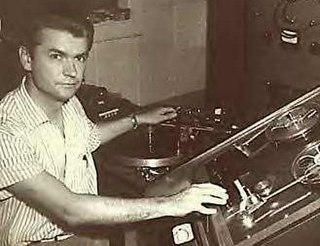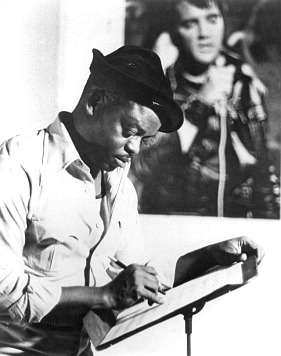Related Research Articles

Samuel Cornelius Phillips was an American record producer. He was the founder of Sun Records and Sun Studio in Memphis, Tennessee, where he produced recordings by Elvis Presley, Roy Orbison, Jerry Lee Lewis, Carl Perkins, Johnny Cash, and Howlin' Wolf. Phillips played a major role in the development of rock and roll during the 1950s, launching the career of Presley. In 1969, he sold Sun to Shelby Singleton.

Jerry Lee Lewis was an American pianist, singer and songwriter. Nicknamed "The Killer", he was described as "rock 'n' roll's first great wild man". A pioneer of rock 'n' roll and rockabilly music, Lewis made his first recordings in 1952 at Cosimo Matassa's J&M Studio in New Orleans, Louisiana, and early recordings in 1956 at Sun Records in Memphis, Tennessee. "Crazy Arms" sold 300,000 copies in the Southern United States, but it was his 1957 hit "Whole Lotta Shakin' Goin' On" that shot Lewis to worldwide fame. He followed this with the major hits "Great Balls of Fire", "Breathless", and "High School Confidential".

Sun Records is an American independent record label founded by producer Sam Phillips in Memphis, Tennessee on February 1, 1952. Sun was the first label to record Elvis Presley, Charlie Rich, Roy Orbison, Jerry Lee Lewis, Carl Perkins, and Johnny Cash. Prior to that, Sun had concentrated mainly on African-American musicians because Phillips loved rhythm and blues and wanted to bring it to a white audience.

Carl Lee Perkins was an American guitarist, singer and songwriter. A rockabilly great and pioneer of rock and roll, he began his recording career at the Sun Studio, in Memphis, beginning in 1954. Among his best-known songs are "Blue Suede Shoes", "Honey Don't", "Matchbox" and "Everybody's Trying to Be My Baby".

Otis Blackwell was an American songwriter whose work influenced rock and roll. His compositions include "Fever", "Great Balls of Fire" and "Breathless", "Don't Be Cruel", "All Shook Up" and "Return to Sender", and "Handy Man".

Sun Studio is a recording studio opened by rock-and-roll pioneer Sam Phillips at 706 Union Avenue in Memphis, Tennessee, on January 3, 1950. It was originally called Memphis Recording Service, sharing the same building with the Sun Records label business. Sun Studio is perhaps most famous for its role in the early years of Elvis Presley’s career.

Class of '55: Memphis Rock & Roll Homecoming is a collaborative studio album by Carl Perkins, Jerry Lee Lewis, Roy Orbison, and Johnny Cash. It was released on May 26, 1986, by America/Smash Records, a subsidiary of Polygram Records. The album was produced by Chips Moman.

Lance R. Guest is an American actor. Known for his film work throughout the 1980s and various television roles thereafter, he made his screen debut with a supporting role in Halloween II (1981). This was followed by headline parts in The Last Starfighter (1984) and Jaws: The Revenge (1987). Between 2010 and 2012, Guest appeared both on and off-Broadway in the musical Million Dollar Quartet, playing Johnny Cash.

"Maybellene" is a rock and roll song by American artist Chuck Berry, adapted in part from the western swing fiddle tune "Ida Red". Released in 1955, Berry’s song tells the story of a hot rod race and a broken romance, the lyrics describing a man driving a V8 Ford and chasing his unfaithful girlfriend in her Cadillac Coupe DeVille. It was released in July 1955 as a single by Chess Records, of Chicago, Illinois. Berry's first hit, "Maybellene" is considered a pioneering rock and roll song. Rolling Stone magazine wrote of it, "Rock & roll guitar starts here." The record was an early instance of the complete rock and roll package: youthful subject matter; a small, guitar-driven combo; clear diction; and an atmosphere of unrelenting excitement.

"Million Dollar Quartet" is a recording of an impromptu jam session involving Elvis Presley, Jerry Lee Lewis, Carl Perkins, and Johnny Cash made on December 4, 1956, at the Sun Record Studios in Memphis, Tennessee. An article about the session was published in the Memphis Press-Scimitar under the title "Million Dollar Quartet". The recording was first released in Europe in 1981 as The Million Dollar Quartet with 17 tracks. A few years later more tracks were discovered and released as The Complete Million Dollar Session. In 1990, the recordings were released in the United States as Elvis Presley: The Million Dollar Quartet. This session is considered a seminal moment in rock and roll.

The Sun Records Collection is a 1994 compilation album released by Rhino Records, compiling some of the finest recordings of the label Sun Records.

The Survivors is a live album by country/rockabilly musicians Johnny Cash, Carl Perkins, and Jerry Lee Lewis, released in 1982 on Columbia Records.

The King of Rock 'n' Roll: The Complete 50's Masters is a five-disc box set compilation of the complete known studio master recordings by American singer and musician Elvis Presley during the decade of the 1950s. Issued in 1992 by RCA Records, catalog number 66050-2, it was soon followed by similar box sets covering Presley's musical output in the 1960s and 1970s. This set's initial long-box release included a set of collectible stamps duplicating the record jackets from every Presley LP on RCA Victor, every single that had a picture sleeve, and most of his EP releases. The set includes a booklet with an extensive session list and discography, and a lengthy essay by Peter Guralnick. It peaked at #159 on the album chart and was certified a gold record on August 7, 1992, by the RIAA. Further certifications were for platinum on November 20, 1992, and for double platinum on July 30, 2002.

Million Dollar Quartet is a jukebox musical with a book by Colin Escott and Floyd Mutrux. It dramatizes the Million Dollar Quartet recording session of December 4, 1956, among early rock and roll/country stars who recorded at Sun Studio in Memphis, which are Elvis Presley, Johnny Cash and Carl Perkins, and newcomer Jerry Lee Lewis. The musical opened on Broadway in 2010, after several tryouts and regional productions, and spawned a 2011 West End production.

Beyond the Sun is the eleventh studio album by Chris Isaak, released through Vanguard Records on October 18, 2011. It is a collection of songs recorded by Sun Records artists Elvis Presley, Johnny Cash, Roy Orbison, Carl Perkins and Jerry Lee Lewis. Some of the songs were originally released on Sun Records. The record itself was recorded at Sun Studio, Memphis, Tennessee and the cover photograph was taken by Sheryl Louis outside the studio on Union Avenue.

"Your True Love" is a 1957 song written by Carl Perkins and released as a single on Sun Records. The single was released as a 45 and 78 backed with "Matchbox" in February, 1957. The recording, Sun 261, reached no. 13 on the Billboard country and western chart and no. 67 on the Billboard pop singles chart that year. The song was recorded on Tuesday, December 4, 1956 when Elvis Presley made a surprise visit to Sun Studios at 706 Union in Memphis, Tennessee. Johnny Cash and Jerry Lee Lewis also participated in the impromptu jam session that day known as the Million Dollar Quartet. Jerry Lee Lewis also played piano on the recording.

"Birth of Rock and Roll" is a 1986 song written by Carl Perkins and Greg Perkins. The song was featured on the Class of '55 album which included performances with Johnny Cash, Roy Orbison, and Jerry Lee Lewis. "Birth of Rock and Roll" was released as a 7" single with a picture sleeve, 885 760–7, on the Smash/America label copyrighted by PolyGram Records produced by Chips Moman. The single reached No. 31 on the Billboard country chart and No. 44 on the Canadian country chart in 1986. The B side was "Rock and Roll (Fais-Do-Do)" which featured Johnny Cash, Jerry Lee Lewis, and Roy Orbison. The theme of the song “Birth of Rock and Roll" is about how "Memphis gave birth to rock and roll" in the 1950s at Sun Records. A video of the song was also made featuring Carl Perkins, Jerry Lee Lewis, and Ronnie Wood of The Rolling Stones as they drove to the historic Sun studios in Memphis, Tennessee in a white Cadillac convertible.

Live at the International, Las Vegas is a live album by Jerry Lee Lewis that was released on Mercury Records in 1970.
Joseph Edward Baugh Jr., known as Smokey Joe Baugh or simply Smokey Joe, was an American rockabilly and country singer and pianist.
References
- 1 2 3 Rudolph, Dietmar. "A Collector's Guide to the Music of Chuck Berry: The Chess Era (1955–1966)" . Retrieved December 4, 2010.
- 1 2 3 4 Gold (CD liner notes). Chuck Berry. United States: Geffen Records/Chess Records. 2005. pp. 20, 27. 0602498805589.
{{cite AV media notes}}: CS1 maint: others in cite AV media (notes) (link) - ↑ "The Chuck Berry Database Details For Recording Session: 19. 4. 1956". A Collector's Guide to the Music of Chuck Berry. Dietmar Rudolph. Retrieved 28 September 2021.
- ↑ Pegg, Bruce (2002). Brown Eyed Handsome Man: The Life and Hard Times of Chuck Berry: An Unauthorized Biography. Routledge. ISBN 9780415937481.
- ↑ "Brown Eyed Handsome Man by Chuck Berry". Rolling Stone . Archived from the original on October 16, 2007.
- ↑ "Chuck Berry: Billboard Singles". Allmusic . Rovi . Retrieved December 3, 2010.
- ↑ Altschuler, Glenn C. (2003). All Shook Up: How Rock 'n' Roll Changed America. Oxford University Press. p. 64. ISBN 9780198031918.
- ↑ Bayles, Martha (1996). Hole in Our Soul: The Loss of Beauty and Meaning in American Popular Music. University of Chicago Press. pp. 149–150. ISBN 9780226039596.
- ↑ McAleer, Dave (2004). Hit Singles: Top 20 Charts From 1954 to the Present Day. Hal Leonard. p. 84. ISBN 9780879308087.
- ↑ "The Irish Charts - All there is to know".
- ↑ "The Million Dollar Quartet - The Million Dollar Quartet, Elvis Presley, Jerry Lee Lewis, Carl Perkins, Johnny Cash - Songs, Reviews, Credits". AllMusic . Retrieved 18 February 2019.
- ↑ "She Even Woke Me Up to Say Goodbye - Jerry Lee Lewis - Songs, Reviews, Credits". AllMusic . Retrieved 18 February 2019.
- ↑ Zielinski, Peter James. "Photo Coverage: MILLION DOLLAR QUARTET Opens on Broadway". BroadwayWorld.com. Retrieved 18 February 2019.
- ↑ "Song List" and "Performing Credits". Million Dollar Quartet (2010). CD booklet. p. 5. New York: Avatar Studios; Chicago: Chicago Recording Company.